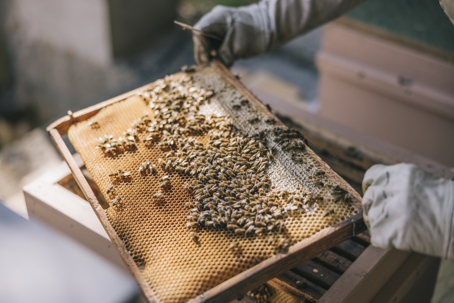How to Get Rid of Honeybees WITHOUT Harming Them
If you have flying bees, wasps, or hornets around your home here are the important things to know:
- There are a variety of flying and stinging insects in Georgia. It is very important that you identify what you are dealing with before treatment is started. They all have different habits that affect the success of removal and structural treatments.
- Many flying bees and insects also can sting! Their venom can cause painful rashes and even extreme reactions in people who are allergic.
- It is important to engage a professional to remove flying and stinging insects from your home.
Honey Bee Removal & Rehoming
If honeybees have been identified around or inside your home they will need to be rehomed and their hive contents (comb, nectar, eggs, honey, and wax) removed. If bees are just exterminated and the hive is left behind, the contents will begin to melt in the hot Georgian sun. When the beeswax melts honey can ooze out of the comb, leaving the potential for that homeowner to be stuck with a sticky mess inside their wall—along with any insects and rodents the wax and honey attracts.
Why Did the Bees Just Appear?
Most homeowners may not know they have a colony of bees as the bees rarely leave the hive in cold weather. In the winter months (Oct-Jan), bees remain dormant in the hive. Bees consume the pollen and honey during the winter months that they have worked all summer to store in their hive.
In January, the queen bee starts laying eggs to prepare for the spring. Then from February to April, the bees start to venture out from the hive. Baby bees hatch out and the colony grows. As they outgrow their hive, a portion of the colony splits off (aka “swarms”) to find a new home.
A swarm is just a collection of honey bees that have not found a new home yet. They find a temporary landing spot and the bees can stay there for anywhere from a half hour to six days (typically 2-3 days). Once the scout bees have identified a new permanent home, the swarm leaves their temporary resting spot and moves into their new residence.
Homeowners often will see the swarms in transition, or they will find out there is a colony already established in their home.
Can I Just Leave the Bees Alone?
Yes! Bees have a unique ability to keep the hive at a constant 95 degrees F, both in the summer and in the winter. They cool the hive by fanning the air with their wings and heat the hive through the use of several bees that are “heaters.” While the bee colony is healthy and strong, there is less worry of comb melting and honey leaking into the structure because of this ability.
However, bees typically don’t completely vacate a hive after it’s been established, so be prepared to have more bees (and more comb hidden in the structure). If you later decide to remove the bees, it will cost more to remove the bees and to repair the void following removal because there will be more bees, more comb, and more honey to remove.
Another consideration is the proximity of the hive to pets or people. A beehive that has an opening by the front door could present a most unwelcome greeting for guests.
Can I Just Kill the Bees With an Insecticide?
No. Killing honeybees (such as with spray) will simply kill the bees…but will leave the beeswax, comb, honey, and brood behind. As the beeswax melts, the wax, nectar, and honey can leak inside your walls. The dead bees and dead eggs can rot. This creates a lure for other insects and rodents.
How Will You Remove the Honeybees?
Our recommended beekeeper will remove the honeybees, eggs, larvae, comb, nectar, and honey from the structure and will disinfect the area. The bee colony will be placed in a hive box, removed from your property, and rehomed. The comb, honey, and young insects will be placed into the hive box with the adult insects to make the rehoming as stress-free as possible. The void from where the hive was removed will need to be sealed and finished by a contractor to ensure the home looks as good as new.
What Happens to the Rehomed Honeybee Colony?
Our recommended beekeeper will rehome the honeybees on their personal property for a long and productive bee life.
Why Would a Pest Control Company Want to Remove and Rehome Live Honeybees?
Red Coat is dedicated to eco-friendly preventative pest control. That does not mean spraying. We believe honeybees are essential to our earth’s survival and we have an obligation to foster their healthy existence. Our goal is to assist homeowners with the removal and rehoming of honeybees so we can all live in harmony.
Beginning January of 2023 100% of all structural honeybee removals must be completed by a licensed pest control company and a Certified Honeybee Removal Operator.
The Georgia Department of Agriculture Structural Pest Control Commission has formalized the requirements for these activities into law in July 2021 to go into effect in January 2023. https://agr.georgia.gov/honeybee-control-and-removal.aspx

